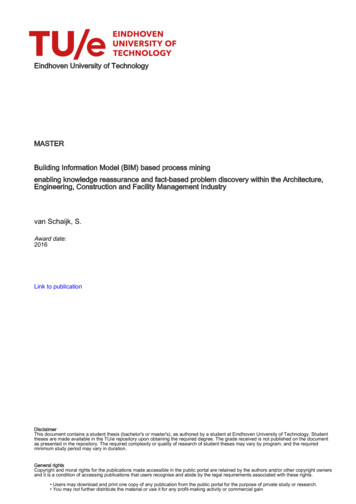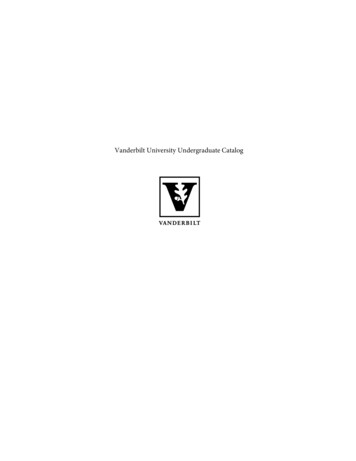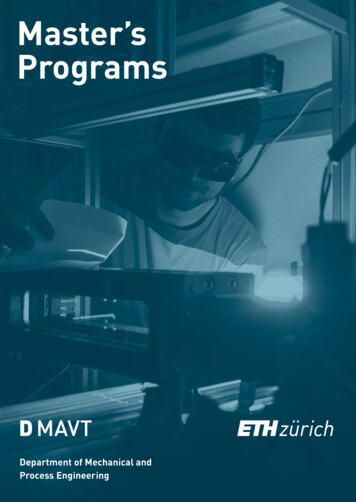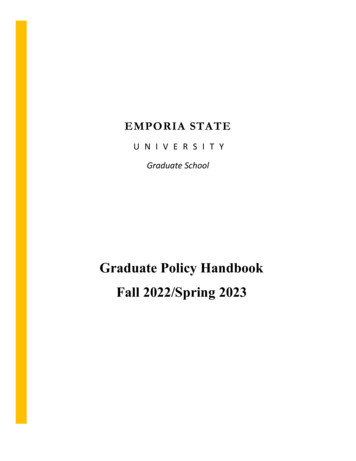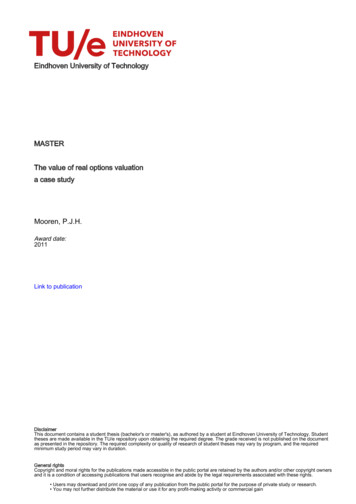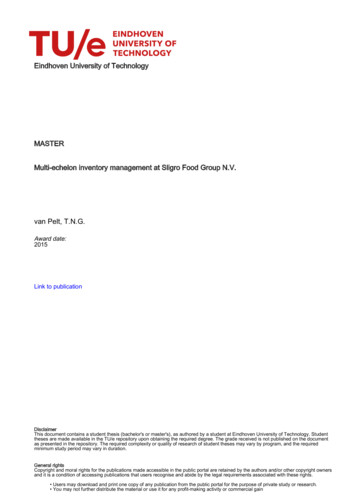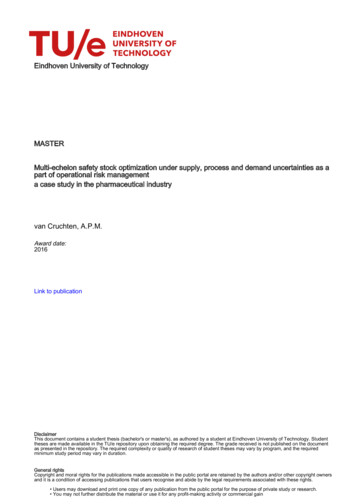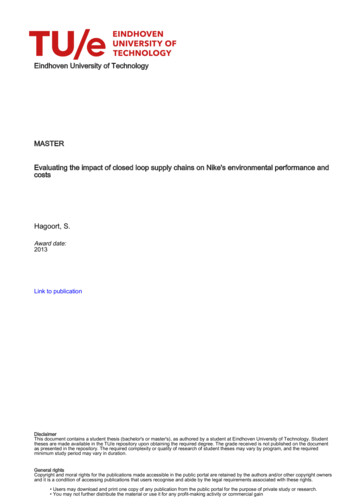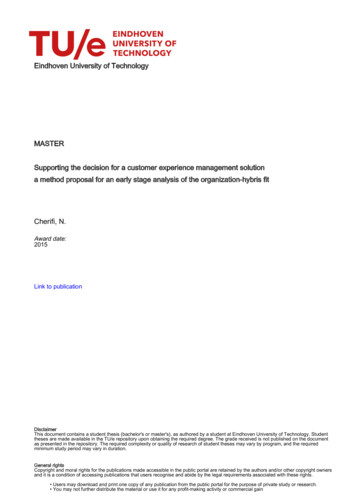
Transcription
Eindhoven University of TechnologyMASTERSupporting the decision for a customer experience management solutiona method proposal for an early stage analysis of the organization-hybris fitCherifi, N.Award date:2015Link to publicationDisclaimerThis document contains a student thesis (bachelor's or master's), as authored by a student at Eindhoven University of Technology. Studenttheses are made available in the TU/e repository upon obtaining the required degree. The grade received is not published on the documentas presented in the repository. The required complexity or quality of research of student theses may vary by program, and the requiredminimum study period may vary in duration.General rightsCopyright and moral rights for the publications made accessible in the public portal are retained by the authors and/or other copyright ownersand it is a condition of accessing publications that users recognise and abide by the legal requirements associated with these rights. Users may download and print one copy of any publication from the public portal for the purpose of private study or research. You may not further distribute the material or use it for any profit-making activity or commercial gain
Eindhoven, March 2015Supporting the Decision for aCustomer ExperienceManagement solution:A method proposal for an early stage analysisof the organization-hybris fit.byNassim CherifiStudent identity number 0655052in partial fulfillment of the requirements for the degreeofMaster of Sciencein Innovation ManagementSupervisors:Dr. C.M. Chituc, TU/e, ISDr. ir. H. Eshuis, TU/e, ISL. Chen, Accenture
TUE. School of Industrial Engineering.Series Master Theses Innovation ManagementSubject headings: Business Decisions, Business Information Systems, BusinessSolutions, Customer Experience Management, Customer RelationshipManagement, Decision Support Systems
AbstractBusiness solutions support organizations in their ability to manage processes. One particulararea of processes is customer engagement. Organizations aim at managing the relationshipwith customers and do so with Customer Relationship Management (CRM). To answercustomer needs and to follow the trend of self-empowered customers in an environment ofpersonalized goods, a need for Customer Experience Management arises. In CustomerExperience Management (CXM), organizations aim at delivering tailored experiences to theindividual customer. Significant differences exist between CRM and CXM. Due to the proactivenature of CXM, data on customers is gathered and used in a different manner and withdifferent goals. To support organizations in delivering these experiences, a business solutionfor Experience Management is beneficial. For business solution vendors as SAP, it is importantto offer organizations a complete portfolio of business solutions. For implementers ofbusiness solutions as Accenture, it is important to be aware of the value of a vendor’sportfolio.As such, in the case of Accenture, SAP and Customer Experience Management, it is importantfor Accenture to identify the value of SAP’s capabilities to offer Customer ExperienceManagement. The Experience Management trend could be fulfilled by a recently acquiredsolution: the hybris Commerce Suite. To identify the value of this solution and to uncoverpotential strategic leverage, the following research question guides this research: How canAccenture be supported in the decision to further investigate hybris as a suitable CustomerExperience Management solution in the light of an organization’s stakeholders? The researchfollows a design science methodology and uses both literature and interviews with Accentureexperts to assure sufficient rigor from which an artefact, in the form of a method, is designed.The executed research is founded on a meta-analysis of two topics. The first topic identifiesthe criteria that depict sufficient performance of a Customer Experience Managementsolution, while the second uncovers the capabilities of the hybris Commerce Suite. Thefindings of this meta-analysis form the fundament of the method proposal that supports thedecision making process for hybris as a Experience Management solution.In the first part of the meta-analysis, a goal model is constructed to model what a CXMstrategy aims for. Its initial goal, to manage the customer journey, is supported by three keygoals: Providing Insights, Orchestrating the Organization and Managing ContextualExperiences. These first two key goals contribute to creating an environment in which the lastkey goal flourishes: by collecting relevant information that allows to make informed decisions,and by forming an organizational structure that supports knowledge exchange and acustomer-centric view, relevant and consistent experiences of high quality can be deliveredto the customer. Conceptual Experiences are relevant when they address the correct of anyof the five phases of the customer journey; Discovery, Attraction, Purchase, Use or Advocacy.Experiences are consistent when they project an organization’s image at every engagement,assuring a recognizable and high quality experience, regardless of the actual phase of theI
journey. By translating these goals in into key goals for a supporting solution, key goals thatact as functional goals of a CXM solution are identified.As sufficient performance is defined as a solution’s ability to support the requirements ofstakeholders in achieving their goals (Neely et al, 2002), a total of nineteen stakeholder roleswith a valid interest in the solution are identified and subsequently mapped. With both thestakeholders and the goals of a Customer Experience Management solution revealed,scenarios in which stakeholders achieve these goals are documented in fully dressed use cases(Cockburn, 1999). These use cases describe the normal way of achieving a goal, and alsoinclude possible detours and problems. Sixty-three possible functional requirements areextracted. These are requirements that the stakeholders have, and that the solution mustsupport when the goals of Customer Experience Management are pursued. The requirementsare grouped under Customer Experience Management aspects derived from the goals:Insights, Orchestration, Designing the experience, Delivering the experience and Theexperience.In the second part of the meta-analysis, both the strategy and the architecture of hybris areinvestigated. Hybris is positioned as the customer portal for all engagement activities withinthe spectrum of business solutions of the SAP portfolio. The means by which it aims to achievethis are documented in a feature model. Hybris is a software product line with a large varietyof features. Each feature can achieve something and is thus a capability. The sum of thesecapabilities depicts hybris’ ability to deliver sufficient performance. Individual features,subfeatures and their hierarchical relations are identified and mapped in the model. Everyfeature is described in detail to document the capabilities of hybris in one of six identifiedareas labeled from A to F. The areas categorize capabilities for content management (B),commerce activities (C), channel management (D) and order management (E). Thesecapabilities are founded on a flexible platform (A) that has supporting capabilities forintegration with SAP or other back-end systems (F).The results of the meta-analysis form the knowledge base to design a method. Whencombined, it delineates the requirements that are supported by hybris. Moreover, it forms anoverview of requirement – feature matches. The results are represented in binary form. Astakeholder requirement is either supported by hybris, or is not supported by hybris. Thelatter group receives a thorough investigation that delivers a documentation of either the lackof support, or the ambiguity of the support by introducing background information or analternative feature to support the requirement. The description of a sequence of steps thatallows a user to extract the requirements for a case-specific situation, in turn, describes amethod that reviews hybris’ performance in a uniform and comprehensible manner. Itprescribes how a user of the method must inform a client-organization, how the requirementsmust be mapped, how hybris’ performance must be analysed, how the preconditions must beanalysed and finally delineates the contents of a concluding report. Moreover, the methoddelivers questions and background information on both hybris capabilities and stakeholderrequirements to facilitate the user of the method. These steps can be executed from theperspective of a skilled, but not necessarily Experience Management familiar expert, in orderII
to deliver support for the decision to further investigate hybris as a suitable CustomerExperience Management solution.The proposed method is validated, in turn, by a case study held with Accenture experts. Thegoal of this case study is to demonstrate how well the results of the method are in line withreality and give a truthful representation of the hybris-organization fit. This is done byperforming two investigations on company X that has adopted hybris. In the first investigation,the proposed method is used to map the requirements and to draft a report, thus executingthe method. Second, an opinion-driven investigation is used to extract the attitude ofcompany X towards the capabilities of hybris and the effect of hybris within the organization.The analysis of both investigations allows to review hybris’ ability to support therequirements, and whether successfully supporting the requirements also positivelyinfluenced the organization. The results show that the investigations do not match a 100 percent. A number of type II errors are identified and as company X had no requirements forseveral aspects of Customer Experience Management, not all elicited requirements werevalidated.The research, overall, successfully followed the design-science research guidelines andachieved its main goal. Several limitations can be identified regarding the use of pre-elicitedrequirements, as the method of collection and their nature might exclude significant andrelevant requirements an organization has. Future work that aims to include these or toexpand the requirements in any other way is therefore recommended. Moreover, not onlythe delivered artifact, but also the rigorous research and design deliver insights that arehelpful for Accenture as it proposes a situation in which in-house qualities of differentexpertise are combined to leverage competitive advantage in the field of CustomerExperience Management.III
PrefaceThis Thesis is the final report that concludes six years of Technical University. It simultaneouslyconcludes six years as a student and rings the bell to start a new phase in my life. But, partiallythanks to this thesis and the accompanying internship at Accenture, I am more than ready todo so.First of all, I would like to thank Accenture for providing me with the means and theopportunity to perform my Master’s Thesis in a large international organization. Within thehighly motivational environment of the Zuidas in Amsterdam, I have had the chance to beintroduced to a lot of interesting topics. I have been able to create a vast network withnumerous possibilities for contacts with ambitious people. This has resulted in greatadmiration for the enthusiasm and skills of Accenture employees, in particular those I haveinterviewed along my research. I am glad that I have been able to have taste of a career afteruniversity in such an inspiring organization. I would like to express my gratitude to Linda Chen,who has allowed me to discover this environment on my own, even when it distracted mefrom my graduation work, and would like to thank her for her support along the way.Second, I want to thank my supervisors from the Eindhoven University of Technology. ClaudiaChituc and Rik Eshuis have provided valuable input and feedback, and have guided methroughout the different phases of my Master’s Thesis up until the graduation.Finally, the support I have had from friends and family helped me to finish this report. Myfriends who provided undesired but highly necessary distraction from time to time. And ofcourse my mother who, at many occasions, assured me that it was all right to take my timeand always stressed that she was sure I would turn out just fine.Nassim CherifiEindhoven, 2015IV
Table of ContentsAbstract . IPreface . IVTable of Contents . V1 Introduction . 12 Methodology . 32.1Introduction . 32.2Research Questions . 32.3Research Design . 42.4Structure of the report . 73 Literature Review . 83.1Introduction . 83.2Customer Relationship Management. 83.3Mass customization and personalization . 83.4An experience: the concept. 93.5Managing an experience: the concept . 93.6Customer Experience Management . 103.7Literature gap and conclusion . 104 CXM solution and hybris: a Meta-analysis . 124.1PART 1: Customer Experience Management solution . 124.1.1Introduction . 124.1.2Customer Experience Management: an elaboration on the concept . 124.1.3Customer Experience Management: a solution . 144.1.4Customer Experience Management: placement and competition overview . 154.1.5Introduction into stakeholders . 174.1.6Onion Model . 184.1.7Stakeholder relations . 214.1.8Stakeholder criteria . 224.1.9Scenarios. 234.1.10 Requirements . 254.2PART 2: hybris . 274.2.1Introduction . 274.2.2hybris: the concept . 274.2.3the hybris Commerce Suite: the features . 284.2.4The hybris Commerce Suite: a feature model . 304.3Conclusion . 305 The Organization - hybris fit: A method proposal . 325.1Introduction . 325.2hybris’ ability to support stakeholder requirements . 325.3Method . 375.4Map the requirements: questions. 385.5Analyze the preconditions: consequences . 395.6Deliver the report: contents . 405.7Conclusion . 406 Validation. 416.1Introduction . 416.2Goal. 416.3Methodology . 426.4Validation. 436.5Conclusion . 467 Conclusion . 47V
7.1Introduction . 477.2Discussion . 477.3Reflection. 487.4Limitations . 497.5Recommendations and future work. 50References . VIIAppendices . XIIIAppendix A . XIVAppendix B. XVAppendix C. XVIAppendix D . XVIIAppendix E . XIXAppendix F . XXXIXAppendix G . XLVAppendix H . LIVAppendix I .LXIAppendix J .LXIIIAppendix K. LXVVI
1IntroductionOrganizations manage the relationship with their customers. The goal is to extract knowledgeand to create more value for the customers. (Boulding et al, 2005) The organization-customerrelationship is handled and governed by Customer Relationship Management (CRM). Themain purpose of CRM, however, is not to create more value for the customer but to createbetter financial performance for the organization. It is the strategic process of selecting andserving the most profitable customers. (Kumar & Reinartz, 2012)Rather than serving customers based with a mass-produced product, a trend that focuses ona customized or even personalized product emerges. Mass personalization allowsorganizations to create what the individual customer desires and to serve the market of oneprofitably. (Kumar, 2007) Organizations can differentiate on the customer experience leveland deliver unique and personal experiences. (Sirotkin & McCabe, 2011; Palmer, 2010)Customer Experience Management (CXM) aims at identifying and understanding individualcustomer values in order to contextualize these into a tailored experience. (Meyer &Schwager, 2007; SDL, 2014; Sirotkin & McCabe, 2011)The adoption and implementation of CRM or CXM requires organizations to invest in newprocesses and supporting business solutions. SAP is a worldwide operating business solutionvendor that offers the SAP Business Suite (Appendix A). This business suite is a portfolio ofdifferent modules. The most important and prominent one is SAP Enterprise ResourcePlanning (ERP). ERP offers a variety of functionalities to help an organization become moreflexible, efficient and effective. It provides a unified view of functions and processes, andreports on activities and transactions of an organization (Lewandowski et al, 2013; Makkar,2012) CRM is an additional module that focuses on the organization-customer relationship.The module offers marketing, sales and service functionalities to help customer-facingdepartments. In 2013, SAP announced it had acquired hybris, an independent e-commercesolution to succeed the in-house SAP e-commerce solution. (Das, 2013)Implementing business solutions in large organizations is a difficult and extensive process.Accenture, commissioner of this research, helps organizations in deciding upon andimplementing business solutions like ERP, CRM and e-commerce. Accenture is a world wideoperating firm, with a focus on management consulting, technology and outsourcing services(Appendix A). Accenture has a partnership with both SAP and hybris. Both organizationscooperate with- and allow Accenture to implement their solutions for client organizations.Accenture implements and leverages SAP products in all possible areas to help organizationperform better. (Accenture, 2014) To help organizations with business solutions, it isimportant to fully comprehend the solutions, hence the interest in the newly arisen situation.For Accenture to deliver a competitive advantage, both for Accenture itself and a clientorganization, it needs to identify the value that hybris has for SAP.SAP has positioned hybris as successor of its e-commerce solution. This solution wasdiscontinued because it was behind on its competition. Its use was limited and highly1
dependent on SAP CRM, and therefore not interesting without the SAP CRM install base(Sheldon, 2013) Effectively, hybris provides organizations with an online marketplace.Moreover, hybris allows organizations to deliver a uniform and consistent experience acrossall channels. It offers a platform to serve businesses (B2B) and consumers (B2C) in both offlinebrick-and-mortar stores and in online environments.Hybris thus provides omni-commerce, serving customers in the best way possible through anydesired channels. It overcomes the complexity of data to manage that occurs from combiningthese channels, including an answer to fulfill the customer’s expectations. (Das, 2013;Henschen, 2013) There is a prospect of a deep integration of SAP ERP and CRM with hybrisand an end goal to connect demand- and supply chains to provide a new business model forclient organizations. The idea is that mastering this process- and data complexity is essentialto create and manage the customer experience (Clark, 2013). Hybris exceeds the possibilitiesof only an e-commerce solution by providing a solution that manages the customerengagement.The prospect that hybris possesses the essentials to deliver Customer ExperienceManagement implies that SAP has acquired more than a simple e-commerce solution. Thequestions that arise are whether hybris can fulfill the role of a CXM module within the SAPbusiness suite, and in what ways Accenture can implement and leverage this solution torealize competitive advantage for its client organizations. Therefore, the goal of this researchis to provide Accenture with a method that supports the decision to further investigate hybrisas a suitable customer experience management solution for a client organization, in the lightof the criteria of the client’s stakeholders.This research in the series Master Theses Innovation Management addresses essential topicsthat are part of the Innovation Management Master’s program. The operational processes ofinnovation are covered by modeling new concepts, including their effect on users and supportin the decision of an innovation. This research aims to support the selection of a highopportunity project in an early stage and to prevent poor investments. Moreover, it supportsthe transition into a new and innovative strategy for organizations. In this particular case, theacquisition of technology by SAP is investigated for its effect on Accenture clientorganizations. Overall, this research investigates the possibilities to increase the innovativestrength of organizations, which is important for its competitive position, but also for society.This research delivers a method that helps Accenture to decide on the appropriateness ofhybris as the suitable solution for a client organization, in an early stage. The method enablesany Accenture employee to deliver a report on the initial fit that is found between hybris’performance and mapped functional requirements of an organization’s stakeholders.Furthermore, the method will help Accenture and their client organizations to understand theconcepts that are introduced in the decision making process of a Customer ExperienceManagement solution.2
2Methodology2.1IntroductionTo clearly define the purpose of this research, a sharp delineation in an unambiguous formhelped to determine the scope, the limitations, and the precise meaning of the words andterms that are significant to this research (Blumberg et al, 2005). Moreover, to provideinformation to guide business decisions, the research contains a systematic and objectiveprocess of gathering, recording and analyzing data. Sreejesh, Mohapatra and Anusree (2014)describe three forms of business research design: exploratory, descriptive and causal.Blumberg et al. (2005) adds the predictive kind that, if there is a plausible explanation, predictswhen and in what situations an event occurs. Such research is rooted in theory as much as theother research designs. The decisions made in this research are discussed in the researchdesign paragraph.2.2Research QuestionsThis research was performed with the goal to support Accenture in the decision to furtherinvestigate hybris as a suitable Customer Experience Management solution for a clientorganization ( ). This goal is a result of the possible strategic and competitive advantage thatis uncovered and can be leveraged by Accenture when it is familiar with the business solutionsit implements for client organizations.Accenture specialists, whether they are a consultant or an integrator, are able to make thedecision to implement a specific solution for a specific problem at a specific organization. Thisprocess, however, can be supported by introducing a comparable, standardized, uniform andconsistent report that investigates the performance of a solution against the requirements ofan organization. Thus, support is realized with a report that analyzes the fit between asolution’s capabilities and the stakeholder’s requirements for that solution. Such a report isnot leading in the decision, but acts as an independent claim that can be used to support thedecision. The main research question is therefore:How can Accenture be supported in the decision to further investigate hybris as a suitableCustomer Experience Management solution in the light of an organization’s stakeholders?To answer this question, it must be divided in three parts or sub research questions. The firstquestion needs to identify when a Customer Experience Management solution deliverssufficient performance. The goal of the research is to deliver support for any organization thatadopts a CXM solution. This sub research question therefore needs to answer when such asolution generally performs sufficiently. To define performance, the definition by Neely,Adams and Kennerley (2002) is used. This definition describes a solution’s performance as theability to satisfy its users: the stakeholders. Stakeholders have goals, and they are satisfiedwhen the solution can supp
In the second part of the meta-analysis, both the strategy and the architecture of hybris are investigated. Hybris is positioned as the customer portal for all engagement activities within the spectrum of business solutions of the SAP portfolio. The means by which it aims to achieve this are documented in a feature model.
